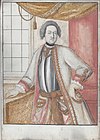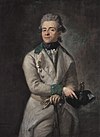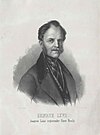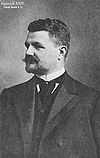Condado Imperial de Reuss
Reuss (alemán: Reuß [ʁɔɪ̯s], ROYSS) era el nombre de varios estados históricos ubicados en la actual Turingia, Alemania. Varios señoríos del Sacro Imperio Romano Germánico que surgieron después de 1300 y se convirtieron en condados imperiales a partir de 1673 y principados imperiales a finales del siglo XVIII fueron gobernados por la Casa de Reuss.
Un número variable de estos condados se crearon por partición; se fusionaron parcialmente y se dividieron nuevamente. Después del final del imperio en 1806, el principado de la línea mayor, así como varios de los más jóvenes, se convirtieron en estados miembros soberanos de la Confederación Alemana, y los más jóvenes se fusionaron en un principado unificado en 1848. Los dos territorios restantes se convirtieron en principados federales del Imperio Alemán en 1871, el Principado de Reuss Elder Line con la capital del estado de Greiz y el Principado de Reuss Younger Line con la capital del estado de Gera. Ambos estados fueron gobernados por la Casa de Reuss hasta la Revolución Alemana de 1918-1919. El jefe de cada rama llevaba el título alemán Fürst (Príncipe, como cabeza de una casa principesca) mientras que sus hijos y todos los demás miembros de la casa llevaban el título Prinz/Prinzessin (Príncipe/Princesa, como miembros agnados de una casa principesca).
Desde finales del siglo XII, todos los miembros masculinos de la Casa de Reuss se llaman Heinrich (inglés: Henry), en honor a Enrique VI, emperador del Sacro Imperio Romano Germánico (1190-1197), a quien debían los dominios de Weida y Gera. A efectos de diferenciación, se les asignan números de orden según determinados sistemas (ver más adelante, apartado Numeración de los Heinrichs), y en la vida privada se les distingue mediante apodos.
Historia de los distintos estados
Al momento de la formación de la Confederación Alemana, varios principados diferentes de la Casa de Reuss que habían existido anteriormente se habían convertido en parte de las dos líneas restantes (la línea Elder y la Menor ). Antes de eso, habían formado parte primero del Sacro Imperio Romano Germánico y luego de la Confederación del Rin.
Orígenes
La región que incluye lo que se convertiría en el Principado de Reuss estuvo habitada a principios de la época medieval por pueblos eslavos que se convirtieron al cristianismo por el emperador alemán Otón I (936–973). En asuntos eclesiásticos, la región estaba bajo la diócesis de Zeitz (fundada en 968), que se convirtió en sufragánea de Magdeburgo. Debido a las frecuentes incursiones de los eslavos, la residencia del obispo de Zeitz se trasladó a Naumburg en 1028, después de lo cual la sede pasó a llamarse Naumburg-Zeitz.
Después de su sujeción a la autoridad alemana, toda la provincia fue asignada a la Marcha de Zeitz. Sin embargo, ya en el año 1000, el emperador Otón III permitió que toda la parte situada en el límite oriental de Turingia, una zona boscosa, escasamente poblada por el pueblo eslavo occidental de los sorbos, fuera despejada para tierras de cultivo y colonizada por colonos alemanes. El emperador Enrique IV nombró a Enrique el Piadoso de Gleissberg (c. 1040-1120) vogt imperial, o alguacil (advocatus imperii) de esta zona de asentamiento, bajo el gobierno de la abadía imperial de Quedlinburg. Era hijo de Erkenberto I de Weida, el antepasado más antiguo conocido de la familia, que se menciona en 1122 en el séquito del conde Adalberto de Everstein en la consagración de la iglesia de San Juan en Plauen. El nombre del área controlada por Heinrich deriva de su cargo: Vogtland (Terra advocatorum, Tierra del Alguacil). Esta designación sigue siendo hasta el día de hoy un resumen geográfico de una región de 3467 km2 (comparable aproximadamente al condado de Essex) que se encuentra en Sajonia, Turingia y, en menor medida, en el norte de Baviera..
La Casa de los Vogts (Alguaciles)
La posición de vogt pronto se convirtió en hereditaria. Mientras que los dominios de Heinrich von Gleissberg incluían las ciudades de Gera y Weida, su nieto Enrique II el Rico (m. antes de 1209) también adquirió Plauen. Cuando sus tres hijos dividieron su herencia, surgieron tres áreas independientes, gobernadas por las ramas de los alguaciles de Weida-Ronneburg, Plauen-Gera y Greiz-Reichenbach. Los alguaciles, inicialmente nobles no libres (Ministerialis), ascendieron rápidamente al rango de señores. Después de la división, el título oficial Vogt se mantuvo en todas las ramas y se transmitió como un feudo imperial hereditario. Cuando los alguaciles negociaron un tratado con Enrique III, margrave de Meissen en 1254, actuaron como socios iguales. En 1329, el emperador Ludwig the Bavarian confirmó a los alguaciles un rango igual al de Príncipes del Sacro Imperio Romano Germánico, aunque sin el título en sí, continuaron usando la designación Vogt.
En los siglos XII y XIII, los alguaciles de Weida se independizaron gradualmente de la abadía de Quedlinburg en las tierras que administraban. Su área incluía lo que generalmente se entiende hoy como Vogtland. Con el tiempo, los dominios de los alguaciles se extendieron más allá de Vogtland hacia los Montes Metálicos Occidentales, con áreas que se extendían hasta lo que ahora es la República Checa.
La rama de Weida se extinguió en 1535, la rama de Greiz-Reichenbach pronto fue heredada por la rama de Plauen-Gera que luego se dividió en Plauen (línea mayor y menor) y Gera-Schleiz-Lobenstein (extinta en 1550). El linaje Plauen mayor de los vogts se extinguió en 1380, el fundador del linaje Plauen más joven fue Enrique (m. alrededor de 1300), quien debido a su estadía en las regiones de Europa del Este y su matrimonio con una nieta del rey Daniel de Galicia recibió el apellido de "der Reusse" (Ruthenus, un término para la Rus de Kiev), de donde el nombre pasó más tarde a su país. Sus descendientes fueron llamados Señores Reuss de Plauen, Greiz y Gera. La Casa de Reuss desciende así de los vogts de Plauen de quienes heredaron las ciudades y señoríos de Gera, Greiz, Schleiz y Lobenstein. Sin embargo, en los siglos XIV y XV los vogts habían perdido la mayor parte de sus posesiones, la mayoría de las cuales recayó en el Electorado de Sajonia, incluyendo Weida en 1427 y Plauen en 1482.
Casa de Reuss
En 1306, la rama Plauen de los vogts se subdividió en una línea mayor (en Plauen) que se extinguió alrededor de 1380, y una línea más joven (en Greiz y Reichenbach), llamada Reuss. En 1564, esta última se subdividió en tres ramas, la Mayor (extinta en 1927), la Media (extinta en 1616) y la Menor (cuya línea gobernante se extinguió en 1945) y una línea lateral, escindida en 1692, Reuss-Köstritz, que había sido elevada a príncipes (aunque no gobernantes) en 1806, todavía existe con unos 30 parientes varones, todos llamados Heinrich, como la última rama superviviente de la familia, con el mayor de esta rama, el Príncipe Reuss-Köstritz, como cabeza de toda la casa, de ahí ahora El Fürst Reuss, mientras que los demás ostentan el título agnaticio de príncipe.
En 1673, los Lords Reuss fueron elevados a Condes Imperiales y (dependiendo de la línea) desde 1778 (1790 o 1802) a Príncipes Imperiales. La dinastía gobernó áreas divididas en varias líneas y sublíneas; alrededor de 1700 había diez condados reussianos de ambas ramas principales. Los señores, condes y príncipes nunca fueron llamados de Reuss, sino conde o príncipe Reuss, ya que Reuss no era originalmente el nombre de una ciudad o castillo, sino un nombre personal. designación para el fundador de la rama que indicaba su conexión extranjera a través del matrimonio (Reussen es de hecho un término alemán más antiguo para rusos), y la familia todavía se menciona hoy en día en el plural como die Reussen.
Debido a las estrechas relaciones de Reuss con los estados vecinos de Sajonia, el luteranismo se afianzó rápidamente en Reuss. Los gobernantes se unieron a la Liga de Esmalcalda contra el emperador alemán y perdieron sus posesiones, pero luego las recuperaron.
Numeración de las Heinrichs
(feminine)Todos los varones de la Casa de Reuss se llaman Heinrich (Henry) más un número. En la línea mayor la numeración cubre a todos los hijos varones de la Casa mayor, y los números aumentan hasta llegar al 100 y luego comienzan de nuevo en 1. En la línea menor el sistema es similar pero los números aumentan hasta el final del siglo antes de comenzar nuevamente en 1. Esta extraña regulación se formuló como una Ley de Familia en 1688, pero la tradición de la uniformidad del nombre estaba en práctica ya en 1200. Fue visto como una forma de honrar al Emperador Hohenstaufen Heinrich/Henry VI, quien crió Heinrich der Reiche/Henry the Rich (+1209) al cargo de preboste de la Abadía de Quedlinburg, asumiendo así el título de vogt.
Partición principal
En 1564 los hijos de Enrique XIII de Reuss en Greiz dividieron las fincas en
- Reuss at Lower Greiz, descendientes de Enrique XIV el Viejo
- Reuss at Upper Greiz, descendientes de Enrique XV el Medio
- Reuss en Gera, descendientes de Enrique XVI el Joven.
Mientras que el Medio Reuss se extinguió en 1616, las líneas Mayor y Menor se dividieron varias veces hasta que en 1778 el Conde Enrique XI unió las posesiones del Alto y Bajo Greiz al Principado de Reuss Elder Line. A cambio, las propiedades restantes de Gera, aunque considerablemente más grandes, se convirtieron en el Principado de Reuss Younger Line en 1806. Los dos principados restantes de Reuss se unieron a la Confederación Alemana en 1815. Varias subdivisiones de Younger Line se fusionaron en un estado unificado en 1848.
Enrique XXII de la línea Reuss Elder se destaca entre los príncipes modernos de esta casa por su enemistad con Prusia, a la que se opuso en la guerra austro-prusiana de 1866, cuando las tropas prusianas ocuparon sus dominios. Enrique se unió a la Confederación de Alemania del Norte y al nuevo Imperio Alemán en 1871. Él fue el único de todos los príncipes confederados que permaneció hasta su muerte en 1902 como un enemigo implacable del príncipe Bismarck y de las condiciones creadas en Alemania por la fundación del imperio. A pesar de sus puntos de vista, su hija Hermine Reuss de Greiz se convirtió más tarde en la segunda esposa del exiliado emperador alemán Wilhelm II. Otras hijas de la casa también realizaron matrimonios importantes: la condesa Augusta Reuss de Ebersdorf, por matrimonio la duquesa de Sajonia-Coburgo-Saalfeld, fue la abuela materna de la reina Victoria y la abuela paterna de Alberto, príncipe consorte. La princesa Augusta Reuss de Köstritz se casó con el Gran Duque de Mecklenburg-Schwerin en 1849 y Eleonore Reuss de Köstritz se convirtió en reina consorte de Bulgaria en 1908.
Heinrich XXIV, Príncipe Reuss de Greiz (1878–1927), era incapaz de gobernar y, por lo tanto, la regencia pasó al príncipe gobernante de la línea más joven de Reuss. Dado que Heinrich XXIV, sin hijos, era el último de su línea, era de esperar que el principado de la línea mayor cayera en manos de la línea más joven después de su muerte, y que como resultado surgiría un estado unido de Reuss. Sin embargo, ambas líneas perdieron sus tronos en la Revolución Alemana de 1918-19 y un estado unido, aunque republicano, el Estado Popular de Reuss, surgió en 1919, solo para fusionarse con el estado más grande de Turingia en 1920. El estado unificado de Reuss tenía una superficie no contigua de 1.143 kilómetros cuadrados y 211.324 habitantes (1919).
Una rama lateral (no gobernante) de la línea más joven había surgido en 1692 cuando Enrique XXIV, conde Reuss de Köstritz, un hijo menor del conde gobernante Enrique I. Reuss de Schleiz, recibió una serie de tierras como herencia. paréage dentro del condado de su hermano mayor, con su sede principal en el castillo de Köstritz. Esta rama conectada a través de matrimonios con importantes casas gobernantes, sin embargo, no gobernó su propio territorio, sino que vivió como terratenientes en el condado de Schleiz Line. Enrique XLIII, conde Reuss de Köstritz, fue elevado a Fürst (príncipe) hereditario por el emperador Francisco II en 1806 (aunque sin poder gubernamental); el paréage de Köstritz permaneció dentro del principado de la línea más joven.
Cuando la línea mayor se extinguió con Enrique XXIV en 1927 y la más joven cuando Enrique XLV, hijo del último gobernante, murió sin hijos en 1945 como prisionero de los comunistas, habiéndose extinguido así ambas ramas principales, la sucesión dinástica (y las pretensiones teóricas a sus tronos) pasaron a la Casa principesca Reuss de Köstritz. Esta línea lateral de Younger Line es, por lo tanto, la única rama de toda la casa que todavía existe hoy, pero tiene más de 30 miembros masculinos, todos llamados Heinrich. El consejo de familia decidió el 5 de junio de 1930 que todos los miembros de la familia restante deberían omitir cualquier adición de línea (Línea más joven o Köstritz) de sus nombres y llamarse a sí mismos Príncipe o Princesa Reuss. Este nombre (así como el conde de Heinrichs) se mantuvo por orden judicial incluso en la república de Weimar. El actual cabeza de familia, Heinrich XIV, dinástico en realidad el Fürst (Príncipe) Reuss de Köstritz (n. 1952), también recibe el nombre de Fürst (Príncipe) Reuss, ya que Köstritz ya no es una línea lateral sino la única sucursal de la casa. Su sede principal es el castillo de Ernstbrunn en Austria, que su familia había heredado en 1822, mientras que el castillo de Köstritz fue expropiado por la Alemania Oriental comunista en 1945 y demolido en la década de 1970. En 1945, los príncipes Reuss perdieron todas sus posesiones y castillos en su patria ancestral a través de la expropiación. Heinrich XIV y algunos de sus familiares recuperaron algunas propiedades en los antiguos estados de Reuss tras la reunificación alemana en 1990.
Consecuencias
Después de la Primera Guerra Mundial, los territorios de Reuss se unificaron en 1919 como el Estado Popular de Reuss, que se incorporó al nuevo estado de Turingia en 1920.
Gobernantes de Reuss
Casa de Reuss
Particiones de Reuss bajo la regla de Reuss
| Lordship of Weida (1122-1531) (También inquilinos (vögtei) 1193-1427) | |||||||
| Lordship of Plauen (1209-1572) | Lordship of Greiz (1a creación) (1209-1219) | ||||||
| Lordship of Greiz (2a creación) (1238-1547) | |||||||
| Lordship of Lobenstein (1a creación) (1425-1489) | Lordship of Schleiz (1425-1547) | Lordship of Gera (1a creación) (1238-1502) | |||||
| Lordship of Burgk (1a creación) (1578-1640) (1667-1697) (Brief 2a creación) | Lordship of Gera (Línea Joven, 2a creación) (1547-1673) Promovido para: Condado de Gera (1673-1802) | ||||||
| Lordship of Greiz (1562-1673) (Lower Greiz a Elder Line; Upper Greiz anexado a Middle Line I; Middle Line Extinto 1616 Middle Line II creada a partir de Elder) Ambas líneas promovieron: Condado de Greiz (1673-1778) (Lower Greiz a Elder Line; Upper Greiz anexó a Middle Line II; Greiz reunificado bajo la línea media II 1768) Middle Line II promovió: Principado de Greiz (1778-1918) | |||||||
| Lordship of Ebersdorf (1671-1673) Promovido para: Condado de Ebersdorf (1673-1848) | Lordship of Lobenstein (2a creación) (1638-1673) Promovido para: Condado de Lobenstein (1673-1824) | Lordship of Schleiz (1666-1673) Promovido para: Condado de Schleiz (1673-1848) Promovido para: Principado Schleiz (1848-1918) | Condado de Kostritz (1692-1918) (De 1748 divididos en Elder, Middle and Younger Lines; Elder Line anexo to Middle Line 1848) | ||||
| Gera dividida entre el remanente Younger Reuss Line territorios | |||||||
Mesa de reglas
- La tabla feudal anterior fue simplificada: había muchas otras divisiones que fueron omitidas, pero aparecerán abajo, como separaciones de corto plazo de los más importantes.
- El uso consistente del nombre Henry. es un homenaje a Enrique VI, Santo Emperador Romano. Cada miembro masculino de la familia tiene este nombre desde la tercera generación de la familia.
- La numeración de los gobernantes expuestos anteriormente son los siguientes:
- Antes de la anexión de Greiz y Gera a Plauen (1547-62), las numeraciones atribuidas son secuenciales. Tenga en cuenta que hay otras secuencias además de la propuesta.
- Después de la liberación del control de Plauen (1547-62), los estados de Reuss se dividieron entre líneas de ancianos, medios y jóvenes. Mientras que la Línea Media siguió la secuencia de preanexación (y fue el primero de los tres a ser extinguidos), los otros dos comenzaron una secuencia y tradición muy extraña, como sigue:
- El Elder Line números cada miembro masculino de la familia (incluso los hijos nacidos) en orden secuencial de nacimiento hasta 100; la numeración se reinicia desde allí.
- El Younger Line números cada miembro masculino de la familia (incluso los hijos nacidos) en orden secuencial de nacimiento hasta finales del siglo; la numeración descansa del primer niño nacido en el nuevo siglo.
Vínculos de los miembros de la rama secundaria con el movimiento Reichsbürger
El 7 de diciembre de 2022, la policía alemana llevó a cabo una operación que resultó en el arresto de 25 presuntos miembros del grupo de extrema derecha Reichsbürger, incluido un miembro de la rama de Köstritz de la Casa de Reuss, identificado como Heinrich XIII Prince Reuss. Los sospechosos arrestados en la operación supuestamente planeaban derrocar al gobierno alemán existente e instaurar a Heinrich XIII como el nuevo líder alemán de facto. Su primo lejano Enrique XIV, el príncipe Reuss, presidente y presidente de la Casa de Reuss y su asociación familiar, se había referido anteriormente a Enrique XIII como "un anciano confundido que se había radicalizado a causa de las decepciones". En nombre de la asociación familiar, que Heinrich XIII había dejado hace años, Heinrich XIV se distanció bruscamente de él nuevamente después de su arresto, diciendo que "hace 30 años era un hombre de negocios moderno, pero hoy en día es engañado por todos. tipos de teorías de conspiración". En la línea de sucesión de la Casa de Reuss, Heinrich XIII solo ocupó el puesto 17, y el jefe de la casa lo llamó 'una figura marginal'. Dijo que su comportamiento fue una "catástrofe" para la familia, cuya herencia como gobernantes tolerantes y cosmopolitas ahora se asociaba con "terroristas y reaccionarios". Él cree que Reuss' Las opiniones antigubernamentales se derivan de su resentimiento hacia el sistema judicial alemán por no reconocer sus reclamos sobre las propiedades familiares expropiadas al final de la Segunda Guerra Mundial.
En la ficción
Un joven conde de Reuss, enviado al Congreso de Viena de 1815, es el protagonista de la opereta Wiener Blut de 1899 y de la película de 1942 basada en ella. Gran parte de la hilaridad de la película se centra en su nombre imposible de 'Reuss-Schleiz-Greiz'.
Contenido relacionado
Donald rumsfeld
Alfonso XIII
Historia de la economía

































